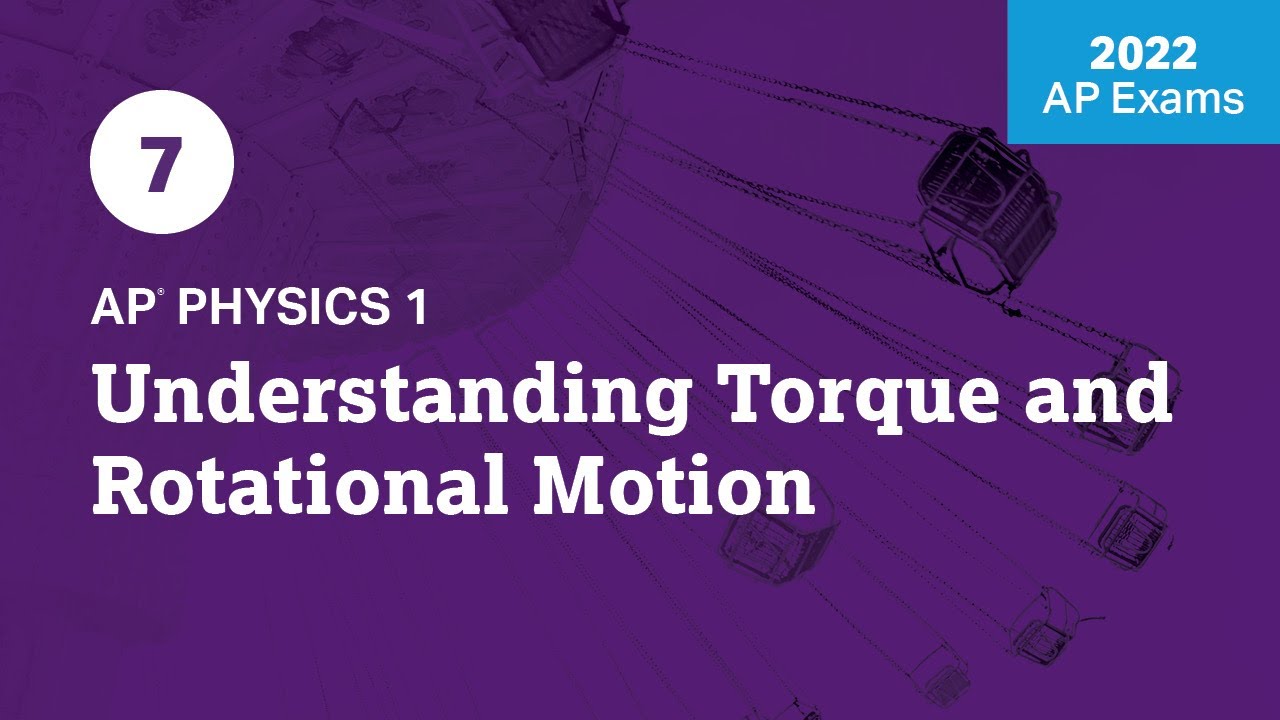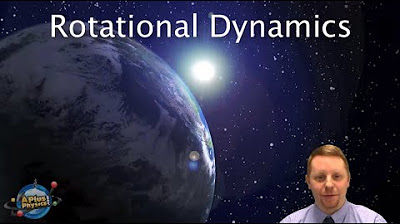2023 AP Physics 1 Free Response #4
TLDRIn this video, the presenter tackles a 2023 AP Physics 1 exam question, providing a solution for calculating the angular acceleration of a disk as a block descends. They discuss the free body diagram, torque, and rotational inertia, leading to the formula for angular acceleration. The video also compares two scenarios involving different pulleys and explains why the change in rotational kinetic energy is greater for a solid disk despite equal changes in angular momentum, due to differences in rotational inertia.
Takeaways
- 📚 The video discusses a problem from the 2023 AP Physics 1 exam, focusing on the block and pulley system and its dynamics.
- 🧩 The problem involves a block with unknown mass attached to a string that wraps around a pulley with negligible friction.
- 🔍 The video aims to determine the expression for the angular acceleration of a disk as the block falls downward.
- 📐 A free body diagram of the disk is created to identify forces acting on it, including gravity and tension.
- 🔄 The net torque on the disk is calculated using the tension force and the radius of the pulley.
- ⚙️ The rotational inertia of the disk is given by the formula \( \frac{1}{2} MR^2 \), where \( M \) is the mass and \( R \) is the radius.
- 📉 The video corrects an algebra mistake made during the explanation, emphasizing the importance of accuracy in calculations.
- 🔄 The relationship between net torque, rotational inertia, and angular acceleration is expressed as \( \text{Net Torque} = I \cdot \alpha \).
- 🔄 The change in angular momentum is explained to be the same for both the solid disk and the hoop due to equal torque and time.
- 🌀 The video explains that even though the angular momentum is the same, the solid disk has a greater change in rotational kinetic energy due to its larger rotational inertia.
- 📈 The difference in rotational kinetic energy is attributed to the solid disk having a smaller angular velocity (\( \Omega \)) for the same angular momentum due to its larger \( I \Omega \) product.
Q & A
What is the main topic of the video?
-The main topic of the video is to discuss and solve problem number four from the 2023 AP Physics 1 exam, focusing on the calculation of angular acceleration and the comparison of angular momentum and rotational kinetic energy for different scenarios involving pulleys and masses.
Why is the video creator providing their best guess at the solutions?
-The video creator is providing their best guess at the solutions because, at the time of the video, the official solutions have not been released yet.
What is the significance of the string being wrapped around a pulley?
-The string being wrapped around a pulley is significant because it allows for the transfer of force from the falling block to the pulley, which in turn causes rotation due to the tension in the string.
What is the formula for the rotational inertia of a solid disk?
-The formula for the rotational inertia (I) of a solid disk is I = 1/2 mR^2, where m is the mass of the disk and R is its radius.
Why is the tension in the string denoted as Ft in the video?
-The tension in the string is denoted as Ft to differentiate it from the general tension T, as the specific magnitude of tension is given in the problem statement and is an important variable in the calculations.
What is the net torque acting on the pulley in the given scenario?
-The net torque acting on the pulley is the tension force multiplied by the radius of the pulley (τ = R × Ft) since only the tension force contributes to the torque due to its position away from the axis of rotation.
How does the video explain the relationship between torque, time, and angular momentum?
-The video explains that the change in angular momentum is equal to the torque applied over time. Since both pulleys in the scenarios have the same force applied at the same distance and for the same time interval, they experience the same change in angular momentum.
What is the difference between the solid disk and the hoop in terms of rotational inertia?
-The solid disk has a smaller rotational inertia compared to the hoop because the mass is distributed closer to the axis of rotation in the solid disk, resulting in a lower moment of inertia for the same mass and radius.
Why is the change in rotational kinetic energy greater for the solid disk than for the hoop?
-The change in rotational kinetic energy is greater for the solid disk because, despite having the same angular momentum, the solid disk has a smaller rotational inertia, leading to a higher angular velocity and thus greater kinetic energy.
What is the formula for rotational kinetic energy in terms of moment of inertia and angular velocity?
-The formula for rotational kinetic energy is KE = 1/2 I ω^2, where I is the moment of inertia and ω is the angular velocity.
How does the video creator plan to correct any mistakes in their solution?
-The video creator plans to post any corrections in a pinned comment below the video once the official solutions are released and any discrepancies are identified.
Outlines
🔍 Analysis of AP Physics 1 Free Response Question 4
This paragraph discusses a hypothetical solution to a 2023 AP Physics 1 free response question involving a block attached to a string around a pulley. The pulley is a solid disk with mass 'm' and radius 'R', and the rotational inertia is given by the formula I = 1/2 * m * R^2. The scenario involves a block falling due to gravity, causing the pulley to rotate. The tension in the string is denoted as 'Ft', and the task is to determine the expression for the angular acceleration 'Alpha' of the disk. The solution process involves creating a free body diagram for the disk, identifying forces, and using the formula for net torque (τ_net = I * Alpha) to find the expression for 'Alpha'. The paragraph also addresses potential corrections to the solution in a pinned comment below.
📚 Comparative Analysis of Pulleys and Rotational Kinetic Energy
The second paragraph delves into a comparative analysis of two scenarios involving pulleys with different rotational inertias. In both scenarios, the pulleys are subjected to the same constant force 'Fa' for the same time interval 'delta T', resulting in the same change in angular momentum due to identical torques. However, the change in rotational kinetic energy is greater for the solid disk compared to the hoop. The explanation involves understanding the relationship between rotational inertia (I), angular velocity (Omega), and angular momentum (L). The solid disk has a larger moment of inertia due to mass distribution further from the axis, leading to a smaller angular velocity despite the same angular momentum. The rotational kinetic energy, defined as 1/2 * I * Omega^2, is thus greater for the solid disk because it rotates faster, despite having the same angular momentum as the hoop.
Mindmap
Keywords
💡Free Body Diagram
💡Angular Acceleration
💡Rotational Inertia
💡Tension Force
💡Net Torque
💡Angular Momentum
💡Rotational Kinetic Energy
💡Solid Disk
💡Hoop
💡Time Interval
Highlights
The problem involves a block attached to a string wrapped around a pulley with negligible friction.
The block is released from rest and falls downward, causing the pulley to rotate.
The tension in the string is denoted as Ft.
A free body diagram of the disc is needed to determine angular acceleration.
Net torque (τ_net) equals rotational inertia (I) times angular acceleration (α), τ_net = Iα.
The rotational inertia of a solid disk is given by I = 1/2 Mr^2.
The expression for angular acceleration α is derived as 2ft/(Mr).
Scenarios 1 and 2 show different pulleys with solid disks and hoops of the same mass and radius.
In both scenarios, the pulleys are pulled by the same constant force F for the same time interval.
After the time interval, the change in angular momentum of the disc is equal to that of the hoop.
The change in rotational kinetic energy is greater for the solid disk compared to the hoop.
Angular momentum change is the same due to equal torque over the same time interval.
The solid disk has a larger rotational inertia because mass is distributed further from the axis.
Even with the same angular momentum, the solid disk spins slower due to its larger rotational inertia.
Rotational kinetic energy is defined as 1/2 Iω^2, where I is rotational inertia and ω is angular velocity.
The hoop has a smaller ω because its mass is further from the axis, resulting in a smaller rotational velocity.
The solid disk has more rotational kinetic energy because it spins faster, despite having the same angular momentum.
Transcripts
Browse More Related Video

Rotational Kinetic Energy and Moment of Inertia Examples & Physics Problems

2022 Live Review 7 | AP Physics 1 | Understanding Torque and Rotational Motion

2018 AP Physics 1 Free Response #3

AP Physics 1 - Rotational Dynamics

Torque: Crash Course Physics #12

AP Physics 1 review of Torque and Angular momentum | Physics | Khan Academy
5.0 / 5 (0 votes)
Thanks for rating: